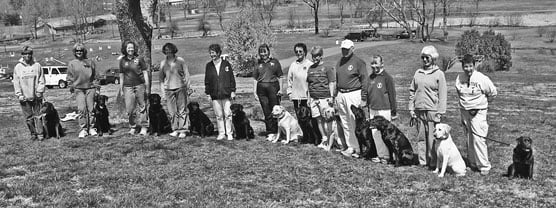When you go to an obedience training class, don’t expect the instructor to train your dog. That isn’t her job. The purpose of the class is to show you what to do, have you try it a few times to make sure you’ve got it right, and then send you home to practice. Be prepared to attend class at least once a week and practice at home at least five times a week.
We think taking Buddy to school is perhaps one of the best things you can do for the both of you. Here’s why:- Classes get you out of the house into an atmosphere where you can spend quality time together and strengthen the bond between you and your dog.
- Both of you have fun while learning useful things that make living together that much easier.
- Classes are excellent way for you to meet similar people and for Buddy to socialize with other dogs.
- Classes usually are economical and keep your training on track with weekly sessions.
- A knowledgeable individual tells you what you may be doing wrong and can help you succeed.
- Classes automatically provide a distracted environment for you to work on communicating with your dog while he’s distracted.
Here are a few drawbacks to consider:
- Most classes are sequential in nature. So, if you miss a class, you’ll fall behind and may have a difficult time catching up. Falling behind is discouraging and may cause you to drop out.
- The schedule and location may be inconvenient.
- The instructor dictates how, what, and when.
- The training method may not be right for you or your dog.
- A group class is full of distractions, which can be frustrating at first.
Good obedience training class criteria
Obedience training classes are offered in almost every community. Until fairly recently, obedience and kennel clubs conducted the majority of classes. Today, however, schools or private individuals also teach classes. The difference has nothing to do with the quality of the training; it relates solely to profit motive. Clubs are nonprofit organizations, and the instructors — usually members who have trained and shown their own dogs — generally volunteer their services. Training schools and individuals who hang out their shingles are for-profit organizations. Some of the large pet chain stores also offer obedience training classes.To locate a class, ask people you know for referrals, such as your veterinary office, groomer, and friends who own well-mannered dogs. You also can use your favorite Internet browser to search for local dog obedience training classes. You’ll likely have several choices.
Call one of the organizations listed to find out where and when the class meets. Ask whether you can observe a beginner class. Most organizations will allow you to observe a class, but if you aren’t allowed to observe a class, forget that organization. When you do go to observe, leave Buddy at home so he doesn’t interfere with the class and you aren’t distracted.
When you’re at the session, ask yourself a few questions about the class you’re observing:- What is your first impression of the class? You’re looking for a friendly, pleasant, quiet, and positive atmosphere. The training area should be clean.
- Do the dogs seem to have a good time? You can quickly tell whether the dogs are enjoying themselves or whether they’d rather not be there.
- How does the instructor deal with the class participants? You want the instructor to be encouraging and helpful, especially to anyone who seems to be struggling.
- How does the instructor deal with the dogs? You want the instructor to be nice to the dogs, not to yell at them or create anxiety or fear.
- Does the instructor appear knowledgeable? As a student, you aren’t likely to be able to tell whether the instructor actually is knowledgeable, but at least he needs to give the appearance of being so.
- What is the ratio of instructors to students? We always aim for a one-to-five ratio, with a limit of 15 students for one instructor with two assistants.
- Is the space adequate for the number of dogs? Insufficient space can cause aggression and frustration in a class situation.
 A group class of dogs showing off a beautiful Sit-Stay in line.
A group class of dogs showing off a beautiful Sit-Stay in line.- The cost of the class and what is included: For example, our basic training courses — or Level 1, as we call it — consist of six hour-long sessions and include a training collar and leash and weekly homework sheets. What a particular organization includes in its fee varies. At the very least, you should get a homework sheet as a reminder of what was covered in class and what you need to work on during the upcoming week.
- The goal of the program: What can you expect from your dog after completing the class? What do they teach in the class? Does it match what you’re hoping to learn? Often the instructor teaches more in class than what you realized you needed, which can be a good thing. Your main goal after all should be to discover how to train your dog.
Puppy classes
Taking Buddy to a puppy obedience training class is the best investment you can make in his future. The benefit of taking a puppy to class is that he can socialize with other young dogs and have fun, yet learn manners and the proper way to interact with his own kind. Buddy’s brain at this point in his young life is like a sponge, and he’ll remember nearly everything you teach him now for the rest of his life. He’ll learn all those lessons that will make him an ideal pet.Look for an organization that offers puppy classes, preferably one that teaches basic control instead of just socialization and games. Nothing is wrong with socialization and games; both are necessary, but at the right time and in the right context. Look for a class where the people are having fun with their dogs and where the instructor is pleasant and professional to the students. Above all, you want to see happy dogs.
You want Buddy to view meeting other dogs as a pleasant but controlled experience, not one of playing and being rowdy. As he grows older, playing and being rowdy is no longer cute and will make him difficult to manage around other dogs.The ideal puppy class allows the puppies to interact with each other for up to three minutes before the class starts for the first two classes only. After the second week, the puppies should be allowed to play for three minutes after class. By delaying playtime, Buddy learns that he must be obedient to you first and that the reward of playing comes after he has worked. This practice will help develop a lifetime habit that you want to instill while he’s young.
Stay away from classes where you’re told that Buddy is too young to learn obedience exercises. This type of organization shows a lack of knowledge of dog behavior.
You can expect your puppy to learn Sit, Down, Stand, Come, and Stay, all on command; he’ll also learn to walk on a loose leash. An excellent program, with well-trained instructors, also will train Buddy to do the same exercises off leash as well as on signal. For Buddy, these exercises are easy stuff.Advanced classes
Most people who go on to advanced training start training their dogs in a beginner class. They then discover that the organization offers more advanced training as well as different activities. For example, you may find that in addition to obedience training the organization offers other types of training such as Rally or Agility (which we discuss more in Chapter 25). Or you may discover that some of the members have therapy dogs and so on. You may enjoy training and wish to broaden Buddy’s horizons. If you and Buddy enjoy what you’re doing, go for it.To train for participation in performance events, join an organization that offers training at that level. The organization’s instructors can coach you and your dog in the intricacies of the various requirements.

